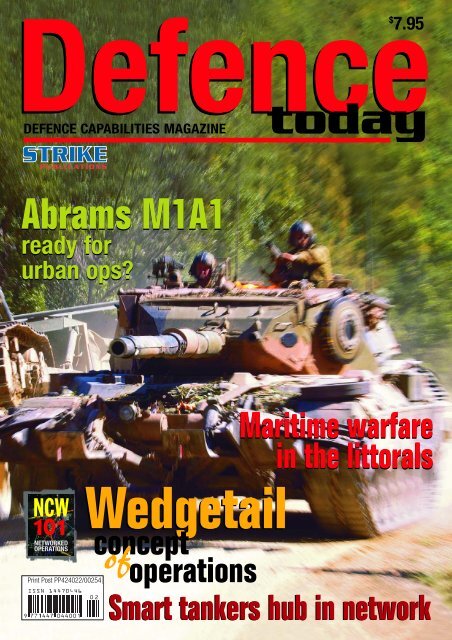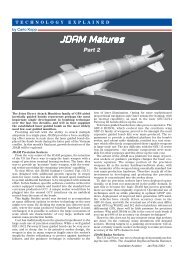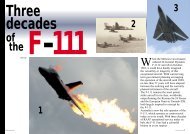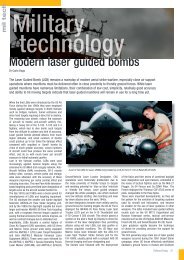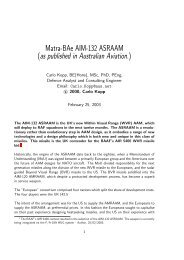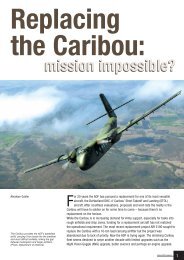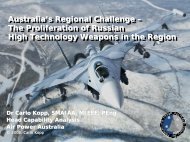Digital Datalinks and Networks - Air Power Australia
Digital Datalinks and Networks - Air Power Australia
Digital Datalinks and Networks - Air Power Australia
You also want an ePaper? Increase the reach of your titles
YUMPU automatically turns print PDFs into web optimized ePapers that Google loves.
Defence<br />
DEFENCE CAPABILITIES MAGAZINE<br />
Abrams M1A1<br />
ready for<br />
urban ops?<br />
NCW<br />
101<br />
NETWORKED<br />
OPERATIONS<br />
Print Post PP424022/00254<br />
Wedgetail<br />
$ 7.95<br />
today<br />
Maritime warfare<br />
in the littorals<br />
concept of<br />
operations<br />
Smart tankers hub in network network
NCW<br />
101<br />
NETWORKED<br />
OPERATIONS<br />
<strong>Digital</strong> datalinks<br />
<strong>and</strong> networks<br />
<strong>Digital</strong> datalinks exhibit the technology at<br />
the heart of modern wireless networks, <strong>and</strong><br />
thus are also the technological basis of<br />
systems supporting Network Centric<br />
Warfare <strong>and</strong> Network Enabled Operations.<br />
Despite the pivotal importance of datalinks,<br />
<strong>and</strong> networks, the technological issues<br />
central to these areas are not well<br />
understood outside the relatively narrow<br />
communities of scientists <strong>and</strong> engineers<br />
who develop <strong>and</strong> support the technologies.<br />
In a sense this should not come as a<br />
surprise since the technologies are<br />
inherently complex. However,<br />
underst<strong>and</strong>ing fundamental issues does not<br />
require high-level qualifications – <strong>and</strong> this<br />
NCW 101 Part II aims to explore the basics<br />
in datalinks <strong>and</strong> networks.<br />
One of the first platforms to deploy the new<br />
JTRS terminals will be US <strong>Air</strong> Force tankers,<br />
as tankers are ubiquitous in the battlespace<br />
<strong>and</strong> thus provide persistent presence.<br />
34 DefenceTODAY magazine<br />
Network Centric<br />
Warfare<br />
Fundamentals<br />
Dr Carlo Kopp<br />
simplest of terms, a digital datalink is<br />
the wireless equivalent of a modem used<br />
Inthe<br />
to communicate over a cable. Early digital<br />
datalinks emerged during the 1950s <strong>and</strong> 1960s<br />
<strong>and</strong> often by design differed little from voiceb<strong>and</strong><br />
modems used for communication over telephone<br />
lines.<br />
The simplest possible voiceb<strong>and</strong> modem running<br />
over a telephone line emits a tone that is modulated<br />
to carry a stream of digital data – effectively<br />
transmitting either ‘1’ or ‘0’ at any given time. Very<br />
simple modulation schemes such as Frequency<br />
Shift Keying (FSK) increases or decreases the pitch<br />
of the transmitted tone depending on whether a<br />
digital ‘1’ or ‘0’ is being sent. The modem at the<br />
other end of the link recognises the changing tone<br />
<strong>and</strong> demodulates the traffic to produce a stream of<br />
digital data - ‘1’ or ‘0’ in digital form.<br />
A simple (or ‘dumb’) modem of this type does not<br />
interpret the stream of digital data it is carrying, or<br />
the structure of the digital data. The next step in<br />
modem evolution was the incorporation of a digital<br />
interface, capable of underst<strong>and</strong>ing the digital<br />
format <strong>and</strong> buffering it.<br />
Radio datalinks of comparable complexity did not<br />
differ significantly from voiceb<strong>and</strong> modems. Rather<br />
than impose the digital modulation onto a<br />
voiceb<strong>and</strong> carrier wave, they employ a radio<br />
frequency carrier. In effect, a basic radio datalink<br />
transceiver differs little from a voice radio of the<br />
same generation: rather than using circuits to<br />
impose voice modulation, <strong>and</strong> extract voice<br />
modulation in the receiver, a ‘modem-like’ digital<br />
modulator <strong>and</strong> demodulator were used. <strong>Datalinks</strong><br />
permitted direct communications between<br />
computers, which previously had to be sent by<br />
voice, <strong>and</strong> a human operator would then type the<br />
Part<br />
2<br />
message into the computer.<br />
The earliest operational datalink systems, adopted<br />
during the 1960s, were used primarily to feed<br />
target coordinates from ground-based radar<br />
tracking systems into the fire control computers of<br />
interceptor aircraft. This was the era of the Cold<br />
War, where interceptors were the primary defence<br />
against nuclear-armed bombers, <strong>and</strong> the timelines<br />
during an intercept were critical to success. Having<br />
a computer on the ground with direct interceptors<br />
saved critical minutes or seconds.<br />
The basic measure of performance for any digital<br />
communications system is its throughput,<br />
measured in ‘bits/second’, or the amount of data<br />
that can be transferred over a link per second. It is<br />
limited by the parameters of the radio modulation<br />
being used for the link.<br />
Configuring computers to communicate reliably is<br />
not a trivial task. Synchronisation of messages is<br />
critical to success: both machines need to<br />
underst<strong>and</strong> what is being sent across the link, <strong>and</strong><br />
what to do with it. Reliability also becomes an issue<br />
as radio transmissions can degrade or drop out for<br />
a variety of reasons, or be jammed by opponents.<br />
The next step in the technological chain was the<br />
adoption of ‘protocols’ for machine-to-machine<br />
communications. A protocol is a set of defined<br />
rules, <strong>and</strong> defined data formats, understood by both<br />
computers at either end of the link. A protocol<br />
provides a framework for formatting <strong>and</strong> sending<br />
digital messages, <strong>and</strong> a framework for receiving<br />
<strong>and</strong> underst<strong>and</strong>ing digital messages. Protocols<br />
define the exact format of messages being<br />
transmitted, <strong>and</strong> will usually keep track of what<br />
was sent should a message be lost enroute, <strong>and</strong><br />
automatically (<strong>and</strong> transparently) retransmit the<br />
message.
Much of the enormous growth in digital communications since the 1960s, <strong>and</strong><br />
in computer networking, has happened as a result of maturity in protocol<br />
technology. While we have seen more sophisticated digital modulation<br />
schemes appear since the 1960s, nearly all were understood theoretically<br />
during that period. A good example is COFDM used in HDTV, digital stereo <strong>and</strong><br />
high speed wireless networks devised during the late 1960s but too expensive<br />
<strong>and</strong> bulky to use then.<br />
<strong>Datalinks</strong> considered today as ‘legacy systems’ remain in wide use for a range<br />
of applications. Examples include: Link 1, which runs at 1200/2400 bits per<br />
second; TADIL A/Link 11/11B which runs at 1364 bits per second; TADIL C /<br />
Link 4, which runs at 5,000 bits per second; <strong>and</strong> Link 14. Each of these<br />
systems has a defined protocol <strong>and</strong> a defined radio modulation technique.<br />
Assessment of the capabilities of any datalink needs to look at several key<br />
issues:<br />
1. Security of transmission - can the link be easily eavesdropped, <strong>and</strong> can it be<br />
easily decrypted by an opponent? From an operational perspective, security is<br />
critical. The case study of Allied intercepts of the German Enigma system<br />
illustrates the point that knowing an opponent’s every move apriori provides an<br />
enormous advantage in combat. Technological measures adopted to provide<br />
security in datalinks are manifold <strong>and</strong> encryption techniques to encode<br />
transmitted data are a science in their own right. Modulation techniques<br />
designed to be difficult to detect <strong>and</strong> demodulate are another.<br />
2. Robustness of transmission - can the link resist the effects of solar flares,<br />
bad weather, terrain <strong>and</strong> hostile jamming?<br />
Robustness is no less important, as even if an opponent’s messages cannot be<br />
decoded, shutting them down can be almost as useful. Nature can be almost<br />
as capricious as an opponent, <strong>and</strong> this must be managed. High robustness is<br />
achieved by choices in link modulation, transmitted power levels, but also in<br />
protocol design, to allow retransmissions until the message can get through.<br />
3. Transmission capacity or throughput - how much data can the link carry per<br />
second? Throughput is becoming increasingly important, as operators dem<strong>and</strong><br />
the capability to send large blocks of reconnaissance imagery, or observe live<br />
video feeds of surveilled targets. The price to be paid for throughput is in more<br />
complex modulation schemes <strong>and</strong> protocols, more expensive hardware that<br />
usually emits more power, <strong>and</strong> in an increasing dem<strong>and</strong> for scarce radio<br />
frequency spectrum availability. With a plethora of commercial terrestrial <strong>and</strong><br />
satellite services occupying useful radio b<strong>and</strong>s, radio spectrum availability <strong>and</strong><br />
dem<strong>and</strong> for throughput can collide.<br />
4. Communications protocol compatibility - how many systems can underst<strong>and</strong><br />
the message formats being used? The issue of protocol compatibility has been<br />
a headache since the 1960s, <strong>and</strong> arguably will always be. The problem<br />
revolves around two issues: platforms <strong>and</strong> systems equipped with wholly<br />
incompatible datalinks, <strong>and</strong> datalink implementations that are only partly<br />
compatible. The latter is the more insidious, as datalink equipment that is<br />
nominally compatible may differ in detail, to the extent that some message<br />
types will simply not be understood. The result is that the platforms or systems<br />
using such partially compatible datalinks may have only a fraction of the<br />
functionality expected.<br />
In perspective, point-to-point datalinks will remain with us for some time to<br />
come. Other than supporting legacy systems, dedicated datalinks will continue<br />
to be introduced for unique or special applications where the simplicity of a<br />
point-to-point link permits early deployment.<br />
<strong>Datalinks</strong> emerged in strength during the Cold<br />
War to support interceptors tasked with<br />
destroying nuclear armed strategic bombers.<br />
<strong>Networks</strong> vs <strong>Datalinks</strong>?<br />
step-up in the technological hierarchy are networks.<br />
<strong>Networks</strong> take the idea of the datalink one step further,<br />
Thenext<br />
permitting computers to communicate with many other<br />
computers, rather than only a single sibling.<br />
At the basic functional level, networks are mostly systems in which messages<br />
can be sent between arbitrary computers within the system, all sharing some<br />
common datalink scheme <strong>and</strong> protocol.<br />
The ability to send messages to multiple recipients, or gather messages from<br />
many senders, is where much of the power of networking lies. Commercial<br />
networks are primarily divided by their geographical footprint into local area<br />
networks, which span areas of kilometres in extent, <strong>and</strong> wide area networks,<br />
which may be citywide, nationwide or global. While local area networks may<br />
share a common channel, in practice most networks are divided into smaller<br />
chunks, <strong>and</strong> messages are routed between these ‘subnets’ whenever they<br />
need to cross a local network boundary.<br />
The idea of routing is powerful, as it allows local network traffic to be confined<br />
<strong>and</strong> thus not congest other parts of the network. Congestion remains one of the<br />
ongoing issues with all networks, a byproduct of many computers competing<br />
for limited capacity on the network.<br />
One of the most important differences between basic datalink protocols <strong>and</strong><br />
networking protocols is that the latter require a proper addressing mechanism<br />
to identify computers connected to the network. A dedicated datalink may not<br />
require any addressing - the choice of radio channel (frequency) may be<br />
enough to distinguish the systems sharing the channel. Conversely, in a<br />
network with dozens, hundreds, thous<strong>and</strong>s or even millions of systems,<br />
addressing becomes a critical issue.<br />
It is important to note that networks are in effect aggregations of datalink<br />
connections, but use protocols designed for a networking environment where<br />
large numbers of computers must be uniquely identifiable. Many of the issues<br />
that arise with datalinks remain as issues with networks, since the physics<br />
<strong>and</strong> mathematical premise remain largely the same.<br />
DefenceTODAY magazine 35
36 DefenceTODAY magazine<br />
NCW<br />
101<br />
NETWORKED<br />
OPERATIONS<br />
The US Army is placing heavy reliance on the new JTRS WNW protocol to provide connectivity<br />
between l<strong>and</strong> force assets.<br />
Measures of Network<br />
Capability<br />
networks can be<br />
compared through their basic<br />
Likedatalinks,<br />
design parameters. The four<br />
basic issues that apply to datalinks also apply to<br />
networks:<br />
1. Security of transmission<br />
2. Robustness of transmission<br />
3. Transmission capacity or throughput<br />
4. Communications protocol compatibility<br />
However, networks must by design <strong>and</strong> function<br />
also address other design problems:<br />
Address space - how many computers (systems)<br />
can be uniquely identified in the network?<br />
Limitations in address space are what led to the<br />
adoption of the IPv6 protocol, over the current IPv4,<br />
within the Internet. Running out of addresses puts<br />
hard limits on the size of any network, <strong>and</strong><br />
ultimately its geographical extent.<br />
Congestion management - how does the network<br />
cope with peaks in traffic load?<br />
One of the realities of the networking world is that<br />
traffic load varies over time, <strong>and</strong> in periods of peak<br />
activity congestion may occur, as a result of which<br />
throughput can be impaired or traffic discarded. At<br />
the least, the network will slow down over load <strong>and</strong><br />
time critical traffic may be delayed. Unwanted<br />
delays can actually disrupt the function of many<br />
network protocols, especially those carrying time<br />
sensitive traffic like digitised voice or video<br />
streams.<br />
Topology model <strong>and</strong> traffic routing - how is the<br />
network interconnected <strong>and</strong> how does this impact<br />
network capabilities?<br />
Network topologies are a byproduct of the basic<br />
design of the network, <strong>and</strong> reflect the realities of a<br />
shared communications channel, with many users<br />
contending for the channel. Good choices in<br />
topology cope well with localised disruption or<br />
congestion, poor choices do not.<br />
A special case in network topology is the Ad Hoc<br />
Network, now emerging in the new US JTRS<br />
network protocol. Ad Hoc <strong>Networks</strong> are selfforming<br />
<strong>and</strong> the topology depends on which<br />
platforms participating in the network can<br />
immediately provide connectivity to other platforms<br />
in the network. The most common topology models<br />
of interest today are the centralised model<br />
(JTIDS/MIDS is a variant), the hierarchical model<br />
(Internet) <strong>and</strong> the ad hoc model (JTRS, MANET).<br />
It is important that networks be compared or<br />
assessed against all of these cardinal parameters.<br />
Not every network design is well adapted for every<br />
environment, <strong>and</strong> this must be considered in<br />
planning for new networks.<br />
Evolution of <strong>Datalinks</strong> <strong>and</strong><br />
<strong>Networks</strong><br />
process leading up to<br />
today’s menagerie of datalinks <strong>and</strong><br />
Theevolutionary<br />
networks occurred in part because<br />
the military experience mirrors the commercial<br />
domain, but also lags it by at least a decade. There<br />
are important differences between the commercial<br />
<strong>and</strong> military networking worlds: military networks<br />
rely heavily on wireless links while commercial<br />
networks rely more on copper/fibre cabled links;<br />
<strong>and</strong> military networks have to assume hostile<br />
action, especially jamming <strong>and</strong> eavesdropping,<br />
commercial networks much less so.<br />
The key caveat is that both worlds progressed from<br />
a complex mix of specialised <strong>and</strong> proprietary single<br />
purpose datalinks, <strong>and</strong> then networks, which have<br />
progressively been displaced by common <strong>and</strong><br />
shared st<strong>and</strong>ards. Given the significant cost in<br />
retrofitting hundreds or thous<strong>and</strong>s of datalink <strong>and</strong><br />
networking terminals across equipment fleets, the<br />
rate of change in the military domain has been<br />
much slower than in the commercial domain.<br />
Replacing a $100 networking card in a desktop<br />
computer is trivial in costs against integrating a<br />
$250,000 JTIDS terminal in a military jet.
A quick summary illustrates this evolutionary process<br />
convincingly:<br />
1. Link 1 datalink at 1200/2400 bits per second used for<br />
air defence systems, devised <strong>and</strong> introduced in the 1950s.<br />
2. TADIL A / Link 11/11B datalink at 1364 bits per second,<br />
used for naval links <strong>and</strong> ground based SAM systems using<br />
original CLEW DQPSK modulation or newer FTBCB<br />
convolutional coding at 1800 bits per second. It is 1960s<br />
technology.<br />
3. TADIL C / Link 4 datalink at 5,000 bits per second in the<br />
UHF b<strong>and</strong>, used for naval aviation, AEW&C to fighter links,<br />
<strong>and</strong> fighter to fighter links on the F-14 series. It is also<br />
1960s technology.<br />
4. Link 14 datalink used for HF transmission between<br />
naval combatants at low data rates.<br />
5. TADIL J / MIDS/JTIDS / Link 16 network, which is a jam<br />
resistant L-b<strong>and</strong> time division spread spectrum system<br />
based on 1970s technology. This system is the dominant<br />
‘st<strong>and</strong>ard’ at this time.<br />
6. Army Tactical Data Link 1 - ATDL 1 used for Hawk <strong>and</strong><br />
Patriot SAM batteries.<br />
7. PATRIOT <strong>Digital</strong> Information Link - PADIL used by Patriot<br />
SAM batteries.<br />
8. Tactical Information Broadcast System - TIBS used for<br />
theatre missile defence systems.<br />
9. PLRS/EPLRS/SADL are a family of US Army/Marine<br />
Corps datalinks used for tracking ground force units, <strong>and</strong><br />
providing defacto Identification Friend Foe of ground units.<br />
EPRLs is also used for data transmission between ground<br />
units.<br />
10. CDL/TCDL/HIDL/ABIT are US high-speed datalinks<br />
designed primarily for satellite <strong>and</strong> UAV transmission of<br />
imagery. CDL family links are typically assymetric, using a<br />
200 kilobit/s uplink for control <strong>and</strong> management, <strong>and</strong> a<br />
10.71, 45, 137 or 234 Megabit/s high speed uplink, <strong>and</strong> a<br />
specialised for the control of satellite/UAVs <strong>and</strong> receipt of<br />
gathered data. ABIT is a development of CDL operating at<br />
548 Megabits/s with low probability of intercept<br />
capabilities.<br />
11. Improved Data Modem (IDM) is used over Have Quick<br />
II spread spectrum radios to provide low data rate but<br />
secure transmission of targeting coordinates <strong>and</strong> imagery.<br />
It has been used widely for transmission of targeting data<br />
to F-15E/F-16C strike fighters <strong>and</strong> F-16CJ Wild Weasels. It<br />
is essentially an analogue to commercial voiceb<strong>and</strong><br />
modems.<br />
12. TCP/IP (Internet) protocol implementations running<br />
over other channels.<br />
13. JTRS (Joint Tactical Radio System), including the WNW<br />
(Wideb<strong>and</strong> Networking Waveform), <strong>and</strong> TTNT (Tactical<br />
Targeting Network Technology) protocols. JTRS is in<br />
development <strong>and</strong> intended to replace JTIDS with a faster<br />
<strong>and</strong> more flexible system. Initial JTRS terminals will<br />
include interfaces to support most legacy protocols in use,<br />
<strong>and</strong> JTRS will have the capability to carry TCP/IP traffic.<br />
The JTRS system sits at the leading edge of this<br />
evolutionary process, whereas the mature JTIDS/MIDS is<br />
in the process of large-scale deployment in the US, while<br />
the earlier legacy protocols are being progressively phased<br />
out over time.<br />
In operational terms, the network of most interest in the<br />
near term is JTIDS/MIDS, since it is available <strong>and</strong> is now<br />
used by the US often as a defacto IFF system. In terms of<br />
fixed infrastructure facilities, the TCP/IP network is of most<br />
interest.<br />
The reality for the ADF is that as JTIDS reaches significant<br />
penetration across the ADF equipment fleet, JTRS will be<br />
deploying across the US fleet. As a result, the ADF should<br />
be positioning now to acquire JTRS terminals for key<br />
assets, such as Wedgetail, planned UAVs <strong>and</strong> other ISR<br />
systems.<br />
38 DefenceTODAY magazine<br />
Comparing Networking Models<br />
appreciate the strengths <strong>and</strong> limitations of the three leading network<br />
technologies in use, it is illustrative to compare the basic models used. The TCP/IP<br />
Tobest<br />
network protocol suite dominates <strong>Australia</strong>n commercial markets, <strong>and</strong> fixed<br />
Defence infrastructure. It is designed to run over a cable infrastructure, <strong>and</strong> its wireless<br />
extensions are not well adapted for military use, due to poor jam resistance <strong>and</strong> security<br />
mechanism designs.<br />
TCP/IP networks are mostly hierarchical in topology. As a result, such networks are<br />
vulnerable to disruption or destruction of key nodes or links in the network, typically those<br />
that aggregate traffic from large numbers of smaller networks. Another weakness in TCP/IP<br />
is limited security, essentially an artifact of its evolution from a DARPA/NSF funded network<br />
for interconnecting academic, industry <strong>and</strong> defence computers in the US. As a result, it was<br />
implicitly assumed that computers connected to the Internet would be operated by<br />
cooperative <strong>and</strong> well behaved users. The reality of today’s commercialised Internet, flooded<br />
with spam <strong>and</strong> XXX rated websites, indicates the unintended consequences of mixing<br />
technology designed for a secure environment with the uglier realities of the commercial<br />
world.<br />
JTIDS was devised during the 1970s primarily to support air defence operations with a jam<br />
resistant datalink, capable of supporting large numbers of fighters <strong>and</strong> missile batteries in<br />
the high density European theatre. While JTIDS is today largely referred to as network, in<br />
strictly technical terms it is more the shared datalink channel than the network.<br />
JTIDS uses spread spectrum radio frequency modulation techniques for its signal, designed<br />
to resist significant levels of jamming (a future NCW 101 article will explore spread spectrum<br />
techniques in more detail). Unlike conventional ‘point to point’ datalinks, JTIDS uses a<br />
technique called ‘time division multiplexing’ to share the available spectrum between<br />
hundreds of terminals. These may communicate with other terminals within the immediate<br />
footprint of the network, more recently a relay capability has been added to permit multiple<br />
JTIDS networks to interconnect.<br />
Because the timing pulses <strong>and</strong> synchronisation of a JTIDS ‘network’ are centrally controlled,<br />
JTIDS in a sense uses a centralised topology model, <strong>and</strong> where the central node, such as a<br />
warship or surveillance aircraft, routes traffic between JTIDS users, this is unambiguously<br />
the case.<br />
In a high intensity combat environment, any central node upon which the whole network<br />
depends becomes a single point of failure if it is disabled or destroyed. In this respect the<br />
JTIDS model has a weakness, <strong>and</strong> this needs to be carefully addressed in operational<br />
planning.<br />
The JTRS WNW is to use ad hoc networking protocols, in which any entity participating in the<br />
network will route traffic for any other entity, as required. Ad hoc networking systems are<br />
topologically the best choice for military applications as there is no single point of failure in<br />
the network. Ad hoc networks are self-forming <strong>and</strong> self-healing, as no participating terminal<br />
is topologically ‘above’ any other. The difficulty with ad hoc networking is that it is immature,<br />
<strong>and</strong> many aspects of ad hoc network design remain in development.<br />
In conclusion, the basic ideas<br />
underpinning modern digital networks are<br />
not complex, but the technology required<br />
to build them is.<br />
Part 3 next issue ..<br />
JTIDS in detail<br />
Further reading:<br />
http://www.ausairpower.net/isr-ncw.html<br />
http://www.csse.monash.edu.au/<br />
~carlo/adhoc.html<br />
The US Army is a major user of various<br />
point-to-point datalinks, used to provide<br />
connectivity between components of air<br />
defence missile batteries.<br />
NCW<br />
101<br />
NETWORKED<br />
OPERATIONS


